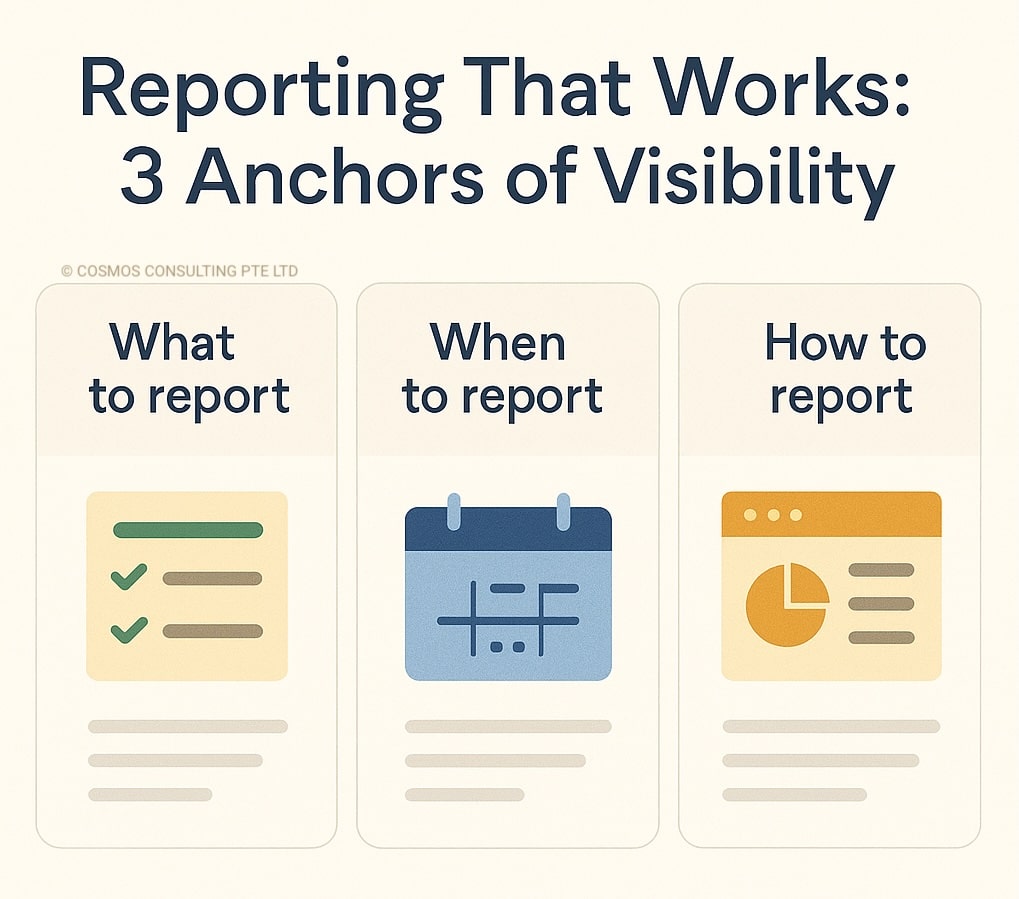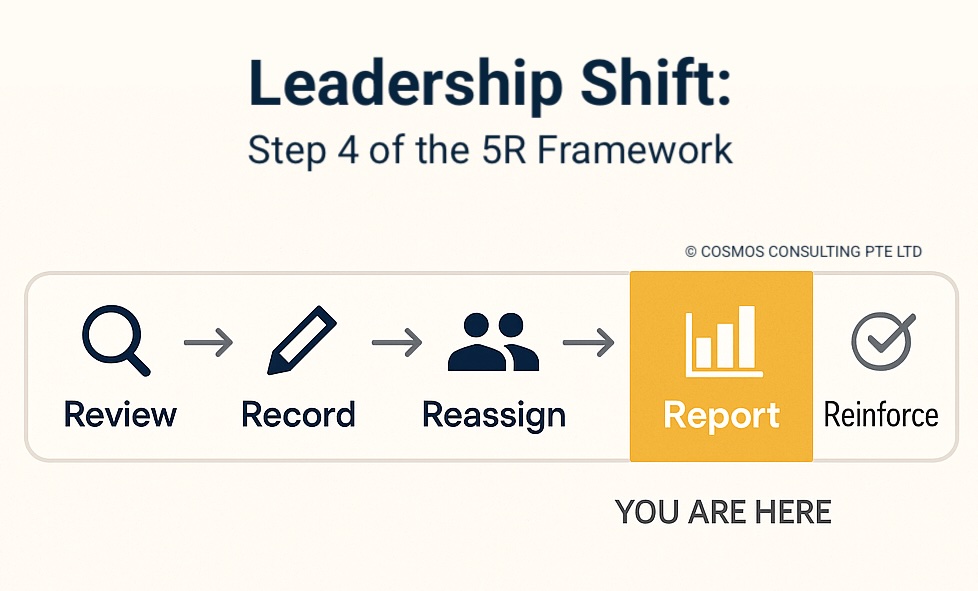Step 4 of the COSMOS 5R Leadership Framework™
You thought you assigned the task.
You even created a tracker.
But now it’s Wednesday… and nothing’s moved.
Sound familiar?
This is what happens when reporting is absent, inconsistent, or dependent on memory. It’s a recurring pattern in nearly every small business we support: visibility breaks, trust follows.

SME founders trying to delegate, but stuck in endless follow-ups.
Reporting isn’t about micromanaging. Progress reporting in small business is where true visibility starts…
… It’s about creating shared visibility, so that everyone knows what’s on track, what’s delayed, and where support is needed.
🧭 Step 4: Report Progress Regularly
This is the fourth step in the 5R SME Leadership Framework:
- ✅ Review what’s stuck
- ✅ Record what should happen
- ✅ Reassign roles with clarity
- 🔶 Report progress regularly ← you’re here
- ⏭️ Reinforce what works consistently
If Reassign created ownership, then Report creates accountability.
💡 This is the fourth step of the COSMOS 5R Leadership Framework™, a practical approach to leading systems without doing everything yourself.

Step back and assess what’s broken

Turn fixes into documented process

Shift clear ownership to the right roles

Create visibility without micromanaging

Make it stick with habits, not hope
🤔 Why Reporting Gets Overlooked in SMEs
In small lean teams, reporting often breaks down due to:
- Updates shared verbally or over WhatsApp.
- Progress buried inside one person’s inbox or memory.
- No routine to surface delays until they become problems.
This leads to the founder constantly asking:
“Did that get done?”
And the team waiting:
“No one followed up, so I assumed…”
This isn’t a team failure.
It’s a systems failure.
📌 This is where the 4S Framework connects.
👉 Read: How Systems Help Teams Self-Manage
🎯 Want a quick way to spot gaps in your leadership?
No sign-up required. Just download and get started.
Password: ccpl_5r#
🎯 What Progress Reporting in Small Business Should Do?

Reporting is not a compliance tool.
It’s a trust builder.
Effective reporting helps teams:
- See what’s moving (and what’s stuck).
- Spot delays early.
- Make smarter, faster decisions.
- Stay aligned without micromanagement.
At Cosmos Consulting, we say:
“If you can’t see it, you can’t scale it.”
That’s the real purpose of Step 4.
🔁 3 Anchors of Effective Reporting

And just like we said in the earlier steps:
You DON’T need a fancy consultant to start reviewing your operations.
You DON’T need complex software to start recording what should happen.
And FOR REPORTING?
You definitely DON’T need flashy dashboards or expensive tools.
What you DO NEED are three things: Clarity, rhythm, and consistency.
Here’s how to build them.
1️⃣ Define What Should Be Reported
Too often, team members aren’t sure what counts as a “report.”
Make it clear:
- Is it a task update?
- A red flag?
- A delivery status?
Use the clarity you created in Step 2: Record what should happen, to set reporting expectations.
👉 Read: Step 2: Record Workflows That Work
🎯 Keep it simple: 1 metric, 1 note, 1 date.
2️⃣ Set a Reporting Rhythm
No rhythm = no visibility.
Examples:
- A Friday update on delivery status.
- A Monday check-in call on top priorities.
- A monthly dashboard shared with leadership.
Small rhythm. Big payoff.
Your job as the founder is not to follow up.
It’s to design a rhythm where updates flow automatically.
3️⃣ Use Lightweight Tools
You don’t need a full ERP system to build visibility.
Start with:
- A Google Sheet tracker
- A Kanban board (like Trello)
- A shared status doc
Tools don’t create clarity… consistency does.
But even a simple dashboard, updated weekly, shifts your team from reporting when chased to reporting by design.
👉 Read: Dashboards Don’t Have to Be Ugly
🛠️ Reporting in Action: A Before-After View
Let’s say Neha handles warehouse dispatches.
Before:
- Updates come only when you ask.
- Delays are discovered after a customer calls.
- You’re stuck chasing every shipment.

After:
- Neha updates the delivery tracker every Friday.
- Delays are flagged automatically.
- The team sees issues before you do.
That’s not reporting for reporting’s sake.
That’s visibility you can trust.
🔄 Reporting Without Ownership Still Fails

Let’s zoom out to the 5R view:
| Step | Focus | Outcome |
|---|---|---|
| 1️⃣ Review | Spot what’s stuck | Understand breakdowns |
| 2️⃣ Record | Define ideal workflows | Establish what should happen |
| 3️⃣ Reassign | Assign true ownership | Clarify accountability |
| 4️⃣ Report | Make work visible | Track progress, reduce follow-up |
| 5️⃣ Reinforce | Build the new normal | Strengthen and sustain changes |
Each step builds on the last.
Without Reassign, reporting falls flat.
Without Report, ownership has no traction.
🚀 Final Thoughts: Visibility Is the Shortcut to Trust
In fast-moving teams, silence is rarely a good sign.
When progress is invisible, trust erodes.
When updates are visible, trust compounds.
Reporting doesn’t need to be perfect.
It needs to be predictable.
And when your team starts reporting without being asked—
That’s when you know your leadership is scaling.
📥 Take the Next Step
Build your team’s trust with clear progress reporting.
👉 Download the COSMOS 5R Leadership Checklist, a simple tool to help you spot bottlenecks and fix them without drama.
🎯 Want a quick way to spot gaps in your leadership?
No sign-up required. Just download and get started.
Password: ccpl_5r#
👉 Or grab the full Dual Framework Guide to see how operations and leadership align.
💡 We use MailerLite to power our lead magnets and client communications. It’s beginner-friendly, powerful, and highly affordable for SMEsOr get the complete guide:
💬 Your Turn
What’s one thing your team should be reporting—but isn’t yet?
Drop it in the comments — I reply to every one.
🛡 Trademark Notice
The COSMOS 4S Systems Framework™ and COSMOS 5R Leadership Framework™ are proprietary tools developed by Chhavi Jain, Director, Cosmos Consulting. These frameworks are unregistered trademarks (™) and may not be copied, reproduced, or repurposed without explicit written permission.
© Cosmos Consulting, 2025. All rights reserved.




